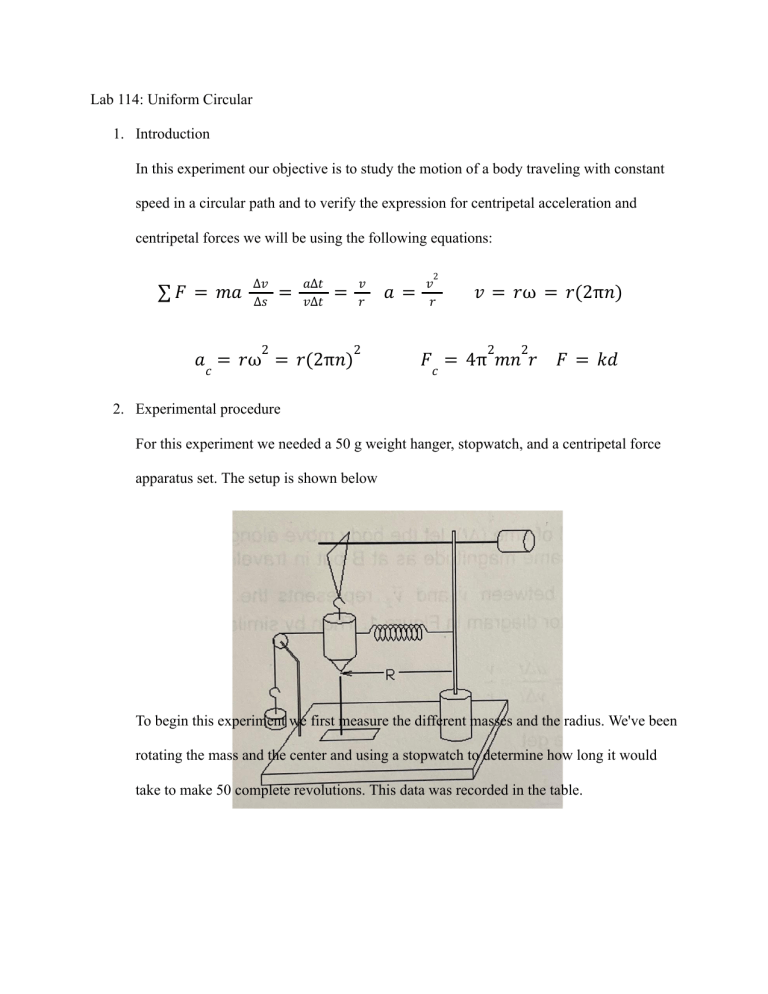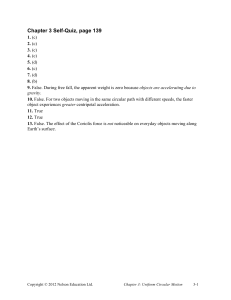
Lab 114: Uniform Circular 1. Introduction In this experiment our objective is to study the motion of a body traveling with constant speed in a circular path and to verify the expression for centripetal acceleration and centripetal forces we will be using the following equations: ∑ 𝐹 = 𝑚𝑎 ∆𝑣 ∆𝑠 = 2 𝑎∆𝑡 𝑣∆𝑡 = 𝑎𝑐 = 𝑟ω = 𝑟(2π𝑛) 𝑣 𝑟 2 2 𝑎= 𝑣 𝑟 𝑣 = 𝑟ω = 𝑟(2π𝑛) 2 2 𝐹𝑐 = 4π 𝑚𝑛 𝑟 𝐹 = 𝑘𝑑 2. Experimental procedure For this experiment we needed a 50 g weight hanger, stopwatch, and a centripetal force apparatus set. The setup is shown below To begin this experiment we first measure the different masses and the radius. We've been rotating the mass and the center and using a stopwatch to determine how long it would take to make 50 complete revolutions. This data was recorded in the table. 3. Results 4. Analysis and discussion 1. What is causing the centripetal force on the body of mass m when it undergoes a circular motion in this experiment? The spring pulling back on the mass along with the weight hanging off the table pulling the mass the other direction caused it to undergo this circular motion. 2. Is the expression (Eq. 5) for centripetal acceleration verified? Is the expression (Eq. 6) for centripetal force verified? Yes, the calculated results were similar to the actual results verifying these equations. 3. Is it possible for an object to have acceleration when the velocity of an object is constant? How about when the speed of the object is constant? An object cannot have acceleration if moving at a constant velocity because velocity is a vector which relates to direction meaning it cannot be moving in a circular motion. If an object is moving at a constant speed in a circular motion the object will be accelerating tangentially to its velocity vector. 4. Consider two people, 1 at the equator, and another at the North Pole. Which has the greatest centripetal acceleration? The one at the equator would have greater centripetal acceleration because their angular velocity would be much higher than that of the one at the North Pole. 5. Suppose we have two identical balls connected to 2 identical strangers. the arrangement is Whirled around in a horizontal Circle as shown below. as it is a world faster and faster which string is likely to break first. The ball further from the center is more likely to break first because it would have a higher angular velocity due to the radius being larger which end result causes the centripetal acceleration to also increase which increases the tension on the string causing it to snap first. 5. Conclucion In this experiment we were able to verify the equation shown above and use them to calculate the force of an object moving the circular motion.


